Innovation in Tigernut (Cyperus Esculentus L.) Milk Production: In Situ Hydrolysis of Starch
Abstract
:1. Introduction
2. Material and Methods
2.1. Sample Origin
2.2. Sample Traitments
2.2.1. Vitamin C Treatment
2.2.2. Tubers Sprouting
2.2.3. Milk Extraction
2.2.4. In Situ Hydrolysis of Milk Starch
- Termamyl HydrolysisTermamyl is an enzyme of bacterial origin; its characteristics are listed in Table 1.To carry out this hydrolysis, 0.1 mL of Termamyl was applied to 100 mL of each sample contained in glass jars and kept under stirring conditions at the temperature of 80 °C in s water bath for 180 min.
- Amylolytic extracts hydrolysis
- -
- Amylolytic extracts preparationAn amount of 25 g of sprouted tigernut tubers was powdered using the Dangoumeau-type mill (Dangoumill 300, Lonjumeau, France) in the presence of N2, and the powder obtained was sieved (500 μm). The powder obtained was transferred to a 250 mL flask and 150 mL of NaCl solution (5%) was added. The mixture was stirred for 15 min using the magnetic stirrer and at room temperature (25 °C). The mixture was filtered using Whatman No. 1 filter paper (9 cm), and the volume of the filtrate obtained was completed with NaCl (5%) at gauge line in the 250 mL flask. The enzyme extract was used after 2 h of rest.
- -
- Amylolytic extracts useExtracts from the sprouted tubers were used as a source of amylolytic enzymes for in situ hydrolysis of starch in milky drinks. The pH of the milky extracts was kept at 6.8 during the tests.To carry out the hydrolysis of starch contained in milky drinks, 0.1 mL of enzyme extract was applied to 100 mL of each sample after heating at 80 °C for 15 min and cooling at 45° C. The mixture was kept under stirring conditions in glass jars at 45 °C (a temperature which corresponds to the maximum activity of amylases of plant origin) [11] in the water bath for 180 min.
- -
- Hydrolysis kineticsIn situ hydrolysis and kinetic analysis of starch in the different milk samples was carried out according to the methods of Goni et al. [12] and Bellmer et al. [13]. According to these methods, 1 mL of each sample was taken every 20 min for 180 min to determine the starch content in the reaction medium.
2.3. Physico-Chemical and Functional Analysis
2.3.1. Amylolytic Activities of Tigernut Tubers
2.3.2. Physico-Chemical Analysis
2.3.3. Rheological Profiles of Milks
2.4. Statistical Analyses
3. Results and Discussion
3.1. Influence of Sprouting on Physico-Chemical Characteristics and Functional Properties of Tigernut Tubers
3.2. Extraction and Physicochemical Characterization of Milks: Influence of In Situ Hydrolysis of Tigernut Starch
3.2.1. Extraction Yields of Tigernut Milk
3.2.2. In Situ Hydrolysis Kinetics of Tigernut Milk Starch
3.3. Chemical Composition of Milks
3.4. Sweetness of Milks
3.5. Rheological Profile of Different Milks
4. Conclusions
- -
- The soaking and hydrolysis of the starch improves the milk extraction yield to almost 70% compared to untreated tubers.
- -
- The different types of hydrolysis lead to an increase in the sweetness of the milky extracts.
- -
- Amylolytic hydrolysis significantly reduces the starch content in the milk extracts and makes them suitable for pasteurization without caking tigernut milk, as shown by rheological profiles.
Author Contributions
Funding
Acknowledgments
Conflicts of Interest
References
- FAO/WHO. FAOSTAT. United Nations Food and Agriculture Organization. 2007. Available online: http://faostat.fao.org/default.aspx (accessed on 22 June 2019).
- Djomdi, D.; Ejoh, R.; Ndjouenkeu, R. Soaking behaviour and milky extraction performance of tiger nut (Cyperus esculentus) tubers. J. Food Eng. 2007, 78, 546–550. [Google Scholar] [CrossRef]
- Djomdi, D.; Kramer, J.K.G.; VanderJagt, D.J.; Ejoh, R.; Ndjouenkeu, R.; Glew, R.H. Influence of soaking on biochemical components of tiger nut (Cyperus esculentus) tubers cultivated in Cameroon. Int. J. Food Process Eng. 2013, 1, 16–28. [Google Scholar]
- Maduka, N.; Ire, F.S. A Review of Some Prevention Strategies against Contamination of Cyperus esculentus and Tigernut Derived Products of Economic Importance. Asian J. Adv. Res. Rep. 2019, 1, 1–13. [Google Scholar] [CrossRef]
- Sánchez-Zapata, E.; Fernández-Lopez, J.; Pérez-Alvarez, J.A. Tigernut (Cyperus esculentus) commercialization: Health aspects, composition, properties and food applications. Compr. Rev. Food Sci. Food Saf. 2012, 11, 366–377. [Google Scholar] [CrossRef]
- Codina, I.; Trujillo, A.J.; Ferragut, V. Horchata. In Traditional Foods, Integrating Food Science and Engineering Knowledge into the Food Chain; Springer: New York, NY, USA, 2016; p. 348. [Google Scholar]
- Adekanmi, O.K.; Oluwatooyin, O.F.; Yemisi, A.A. Influence of processing techniques on the nutrients and antinutrients of tigernut (Cyperus esculentus L.). World J. Dairy Food Sci. 2009, 2, 88–93. [Google Scholar]
- Okorie, S.U.; Nwanekezi, E.C. Evaluation of proximate composition and antinutritional factors of Cyperus esculentus (tigernut) as influenced by boiling. IOSR J. Environ. Sci. Toxicol. Food Technol. 2014, 2, 70–73. [Google Scholar]
- Umeri, S.C.; Enebeli, J.N. Malt caramel from tubers of Cyperus esculentus. Bioressource Technol. 1996, 2, 215–216. [Google Scholar] [CrossRef]
- Garcıa-Jimenez, J.; Busto, J.; Vicent, A.; Armengol, J. Control of Dematophora necatrix on Cyperus esculentus tubers by hotwater treatment. Crop Prot. 2004, 23, 619–623. [Google Scholar] [CrossRef]
- The Amylase Research Society of Japan. Handbook of Amylases and Related Enzymes; Pergamon Press: Oxford, UK, 1988; pp. 72–75. [Google Scholar]
- Goni, I.; Garcia-Alonso, A.; Saura-Calixto, F. A starch hydrolysisprocedure to estimate glycemic index. Nutr. Res. 1997, 17, 427–437. [Google Scholar] [CrossRef]
- Bellmer, D.D.; Huhnke, R.L.; Kundiyana, D. Issues with in-field fermentation of sweet sorghum juice. In Proceedings of the 2008 Providence ASABE Meeting, Providence, RI, USA, 29 June–2 July 2008; ASABE: St. Joseph, MI, USA No. 084828. [Google Scholar]
- AFNOR, (Association Française de Normalisation). Recueil des normes françaises. In Produit Dérivé des Fruits et Légumes; AFNOR: Paris, France, 2002; p. 260. [Google Scholar]
- Edem, D.O.; Ekwere, E.S.; Eke, O.U. Chemical evaluation of the effect of cooking on the nutritive value Conophor seed (Tetraca rpidium conophor). Trop. Sci. 1994, 34, 377–380. [Google Scholar]
- UICPA (Union Internationale de Chimie Pure et Appliquée). Méthodes D’analyse des Matières Grasses et Dérivés, 6th ed.; ETIG: Paris, France, 1979; p. 238. [Google Scholar]
- Mestres, L.; Mestres, C. Détermination de la teneur en amidon des produits céréaliers fermentés. In African Food Tradition Revisited by Research; Food Research Institute: Zeist, The Netherlands, 2011; FP7 n b245025. [Google Scholar]
- Chase, G.; Long, A.R. Liquid chromatographic analysis of all-rac-alpha-tocopheryl acetate, tocopherols, and retinyl palmitate in SRM 1846. J. Liq. Chromatogr. Relat. Technol. 1998, 20, 3317–3327. [Google Scholar] [CrossRef]
- AOAC. Official Methods of Analysis of the Association of Official Analytical Chemists; AOAC: Washington, DC, USA, 2000. [Google Scholar]
- Ejoh, R.; Djomdi; Ndjouenkeu, R. Characteristics of tigernuts (Cyperus esculentus) tubers and their performance in the production of a milky drink. J. Food Process. Preserv. 2006, 30, 145–163. [Google Scholar] [CrossRef]
- Jan, R.; Saxena, D.C.; Singh, S. Physico—Chemical, textural, sensory and antioxidant characteristics of gluten e Free cookies made from raw and germinated Chenopodium (Chenopodium album) flour. LWT Food Sci. Technol. 2017, 71, 281–287. [Google Scholar] [CrossRef]
- Yudkin, J. The Penguin Encyclopedia of Nutrition; Penguin Books Ltd.: Middlesex, Harmondsworth, UK, 1988. [Google Scholar]
- Laxmi, G.; Chaturvedi, N.; Richa, S. The impact of malting on nutritional composition of foxtail millet, wheat and chickpea. J. Nutr. Food Sci. 2015, 5, 407–419. [Google Scholar]
- Traoré, T.; Mouquet, C.; Icard-Vernière, C.; Traoré, A.S.; Trecie, S. Changes in nutrient composition phytate and cyanide contents and a-amylase activity during cereal malting in small production units in Ouagadougou (Burkina Faso). Food Chem. 2004, 88, 105–114. [Google Scholar] [CrossRef]
- Bhathal, S.; Kaur, N. Effect of germination on nutrient composition of gluten free Quinoa (Chenopodium Quinoa). Int. J. Sci. Res. 2015, 4, 423–425. [Google Scholar]
- Chinma, C.E.; Anuonye, J.C.; Simon, O.C.; Ohiare, R.O.; Danbaba, N. Effect of germination on the physicochemical and antioxidant characteristics of rice flour from three rice varieties from Nigeria. Food Chem. 2015, 185, 454–458. [Google Scholar] [CrossRef]
- Ojha, P.; Adhikari, R.; Karki, R.; Mishra, A.; Subedi, U.; Karki, T.B. Malting and fermentation effects on anti- nutritional components and functional characteristics of sorghum flour. J. Food Sci. Nutr. 2018, 6, 47–53. [Google Scholar] [CrossRef]
- Klang, M.J.; Talamond, P.; Djidimbele, N.; Tavea, F.; Ndjouenkeu, R. Partial purification and characterization of α-amylases from Abrus Precatorius, Burnatia Enneandra and Cadaba Farinosa. J. Enzym. Res. 2014, 1, 66–71. [Google Scholar]
- Jaisut, D.; Prachayawarakorn, S.; Varanyanond, W.; Tungtrakul, P.; Soponronnarit, S. Effects of drying temperature and tempering time on starch digestibility of brown fragrant rice. J. Food Eng. 2008, 2, 251–258. [Google Scholar] [CrossRef]
- Otutu, O.L.; Ikuomola, D.S.; Oloruntoba, R.O. Effect of sprouting days on the chemical and physicochemical properties of sorghum starch. Am. J. Food Nutr. 2014, 4, 11–20. [Google Scholar]
- Megat, R.M.R.; Azrina, A.; Norhaizan, M.E. Effect of germination on total dietary fibre and total sugar in selected legumes. Int. Food Res. J. 2016, 23, 257–261. [Google Scholar]
- Abdel-Kader; Michalinos. The nutrient content of tigernut (Cyperus esculentus) tubers. J. Food Compos. Anal. 1963, 10, 205–217. [Google Scholar]
- Brandama, C.; Meyera, X.H.; Prothb, J.; Strehaianoa, P.; Pingaud, H. An original kinetic model for the enzymatic hydrolysis of starch during mashing. Biochem. Eng. J. 2003, 1, 43–52. [Google Scholar] [CrossRef]
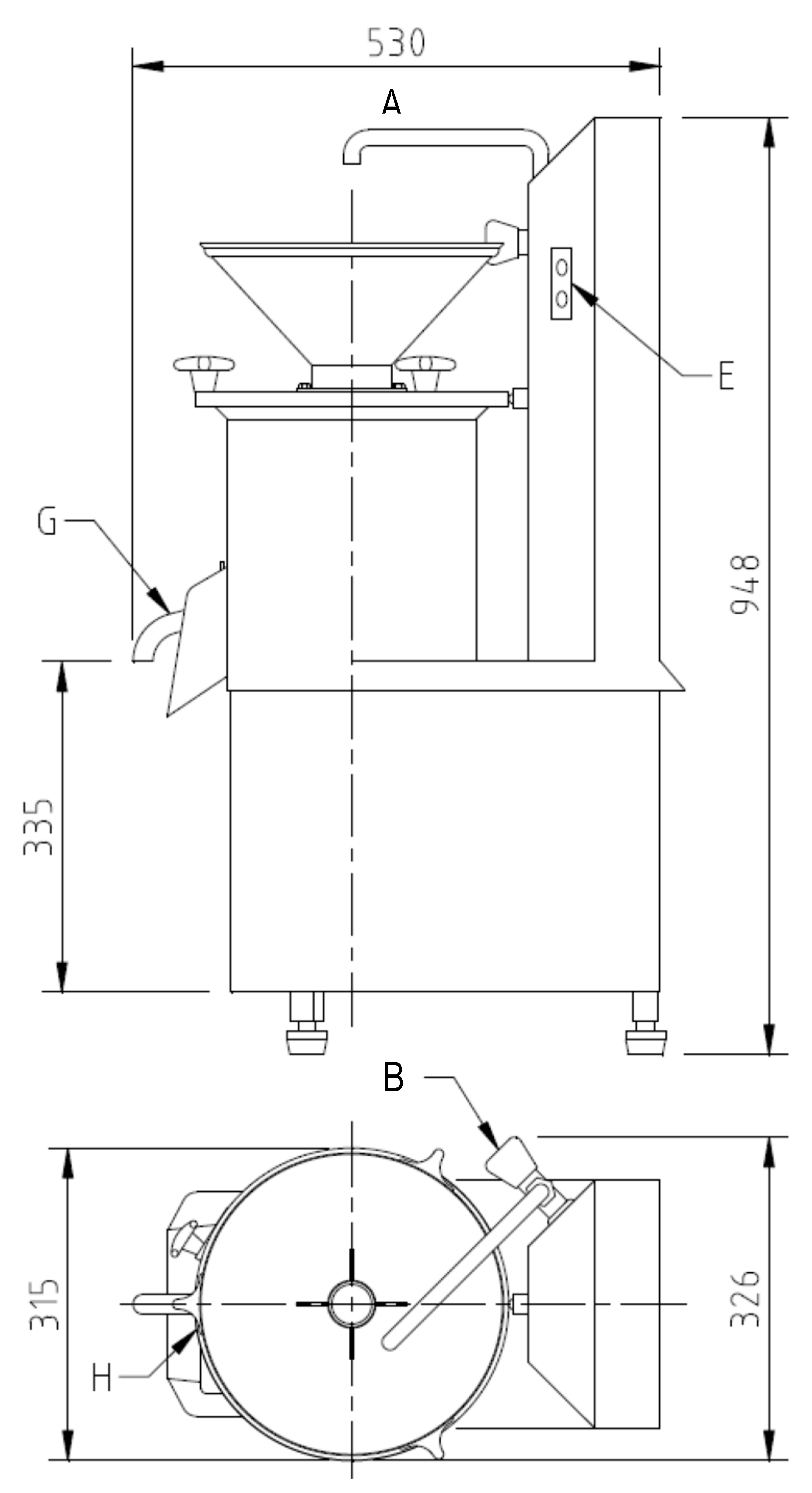
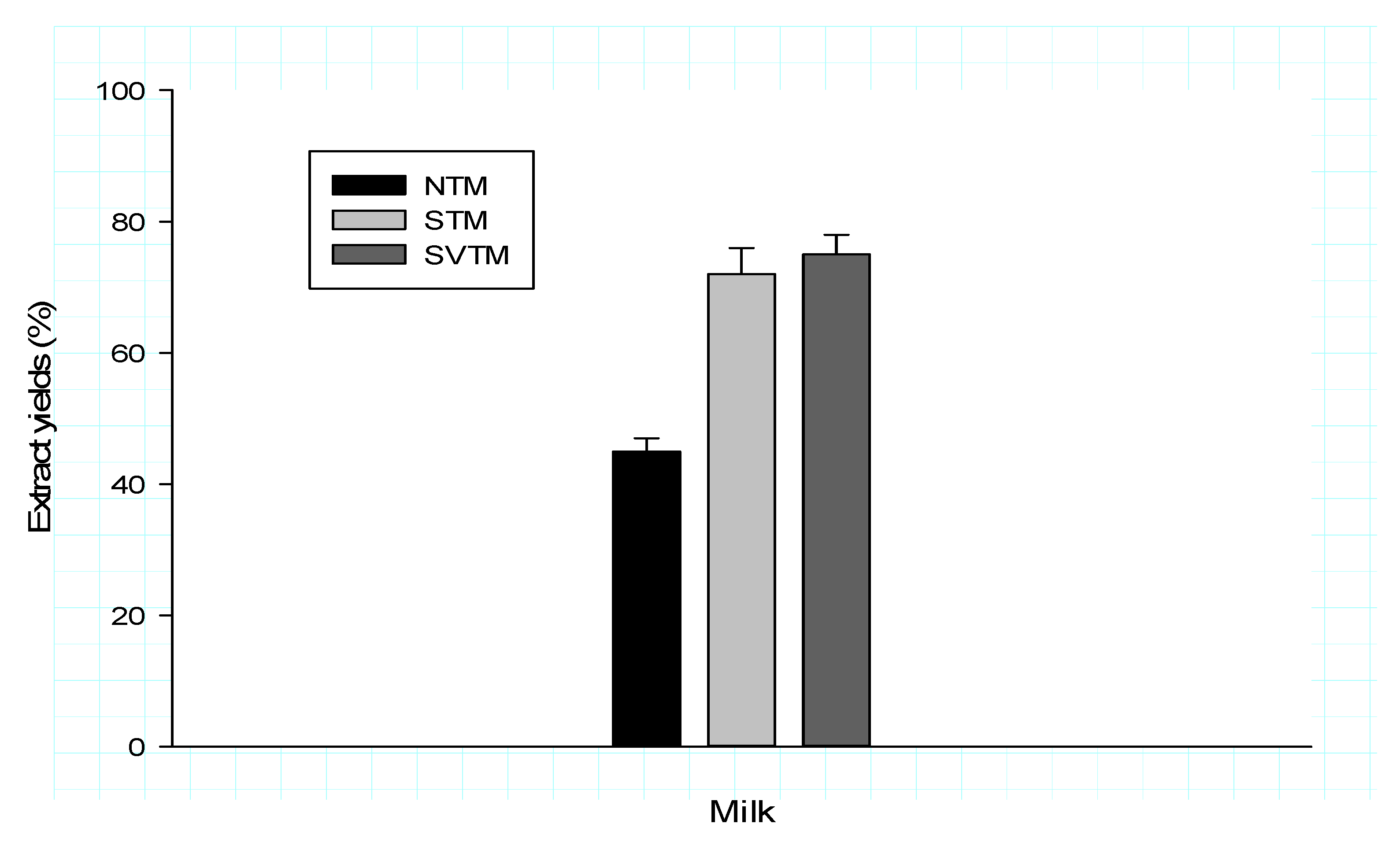
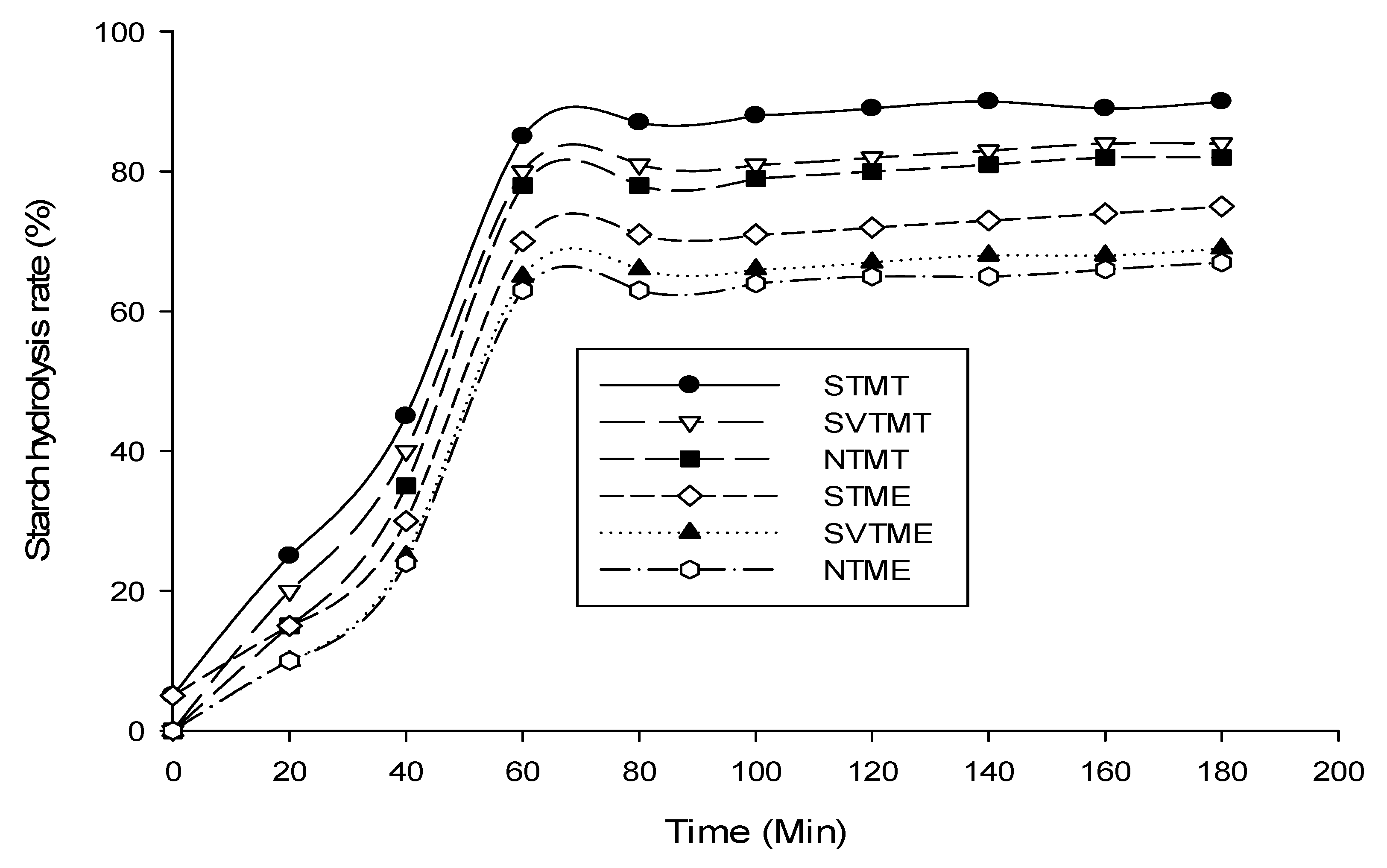
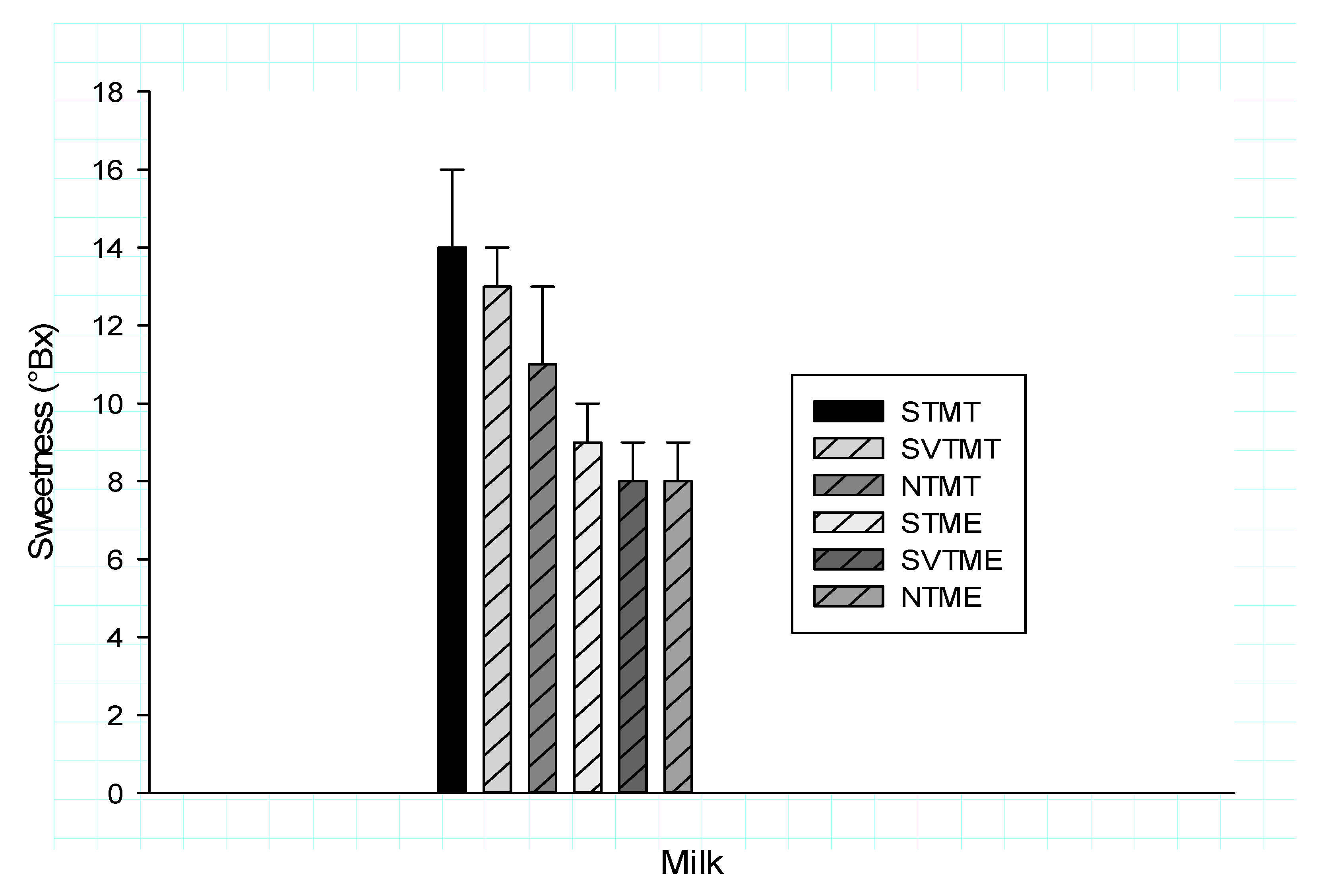
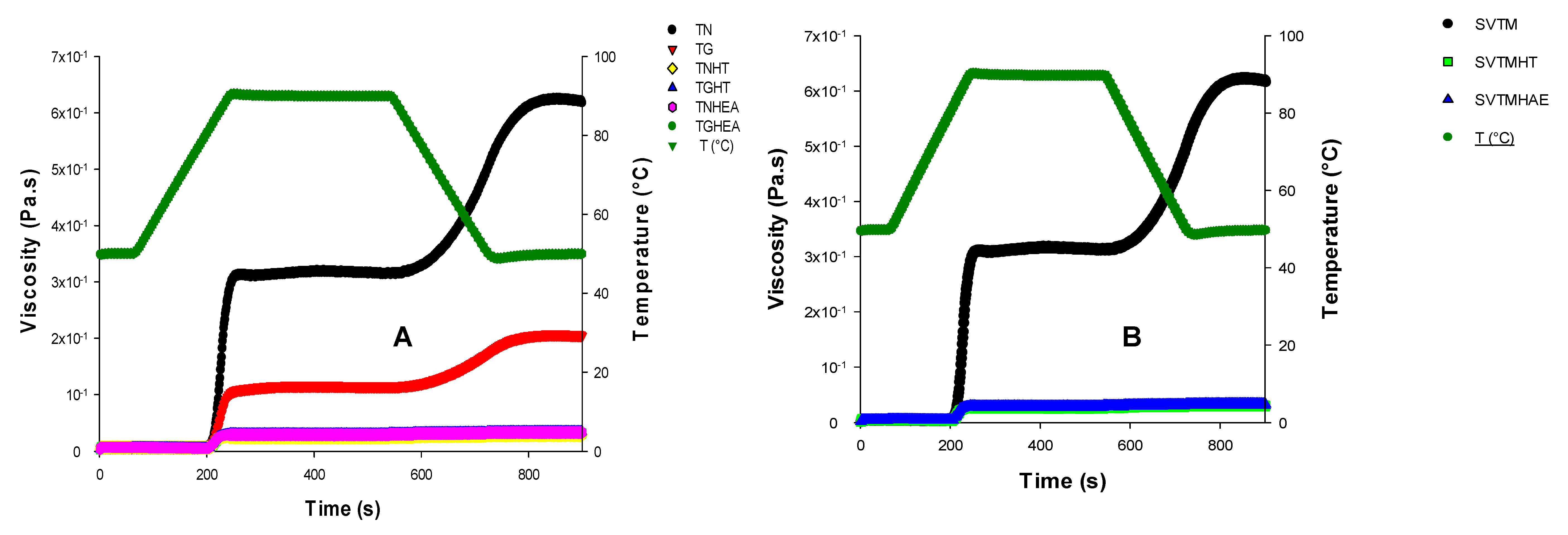
| Enzyme | Class | Origin | Optimal pH Activity | Optimal Temperature (°C) | Enzymatic Activity |
|---|---|---|---|---|---|
| Termamyl 120 L | α-amylase | Bacillus licheniformis | 5.8–7 | 80–85 | 120 KNU g−1 * |
| Characteristics (g/100 g DM) | Sprouted Tubers | Tubers Treated with Vitamin C | Native Tubers (Control Sample) |
|---|---|---|---|
| Water content (%) | 54.38 ± 0.54 b | 57.34 ± 0.23 c | 7.38 ± 0.14 a |
| Protein | 8.82 ± 1.31 a | 7.42 ± 0.42 b | 7.62 ± 0.11 b |
| Total carbohydrates | 48.93 ± 1.18 a | 47.52 ± 1.84 a | 49.92 ± 0.12 b |
| Reducing sugars | 33.36 ± 0.35 a | 23.74 ± 1.74 b | 20.12 ± 1.11 c |
| starch | 16.63 ± 0.50 b | 25.13 ± 0.10 a | 26.14 ± 0.27 a |
| Lipids | 24.15± 0.02 b | 26.25 ± 0.53 a | 25.56 ± 0.41 a |
| Fibers | 15.72 ± 0.09 a | 12.03 ± 0.94 c | 15.56 ± 0.12 a |
| Ashes | 3.84 ± 0.18 a | 1.84 ± 0.07 b | 2.73 ± 0.31 a |
| Vitamin C (mg/100 g) | 275.39 ± 3.41 b | 328 ± 4.37 a | 252 ± 0.39 c |
| Vitamin E (mg/100 g) | 118.73 ± 0.55 a | 118.79 ± 3.26 a | 123 ± 0.18 b |
| Caloric Value (kcal) | 462 | 450 | 445 |
| AA * (U/mL) | 60 ± 3.72 a | 15 ± 0.58 b | 3 ± 1.69 c |
| Parameters (%) | STM | SVTM | STMT | STME | SVTMT | SVTME | NTM |
|---|---|---|---|---|---|---|---|
| Dry matter | 19.22 ± 1.63 c | 18.52 ± 0.43 b | 18.78 ± 1.48 b | 18.82 ± 1.93 b | 18.62 ± 1.15 b | 18.56 ± 1.54 b | 17.41 ± 1.52 a |
| Ashs | 0.92 ± 0.03 b | 0.90 ± 0.09 b | 0.97 ± 0.07 b | 0.94 ± 0.07 b | 0.91 ± 0.08 b | 0.92 ± 0.07 b | 0.70 ± 0.03 a |
| Proteins | 4.22 ± 0.54 b | 2.45 ± 0.97 a | 3.89 ± 0.72 b | 3.75 ± 0.73 b | 2.78 ± 0.54 a | 2.68 ± 0.37 a | 2.47 ± 0.75 a |
| Starch | 7.57 ± 1.44 b | 12.98 ± 1.70 a | 3.85 ± 1.52 c | 4.77 ± 0.95 c | 3.96 ± 0.33 c | 4.85 ± 0.59 c | 12.87 ± 1.95 a |
| Lipids | 4.11 ± 0.68 c | 5.83 ± 0.71 b | 3.95 ± 0.22 c | 4.03 ± 0.06 c | 5.06 ± 0.66 b | 5.53 ± 0.74 b | 6.33 ± 0.31 a |
| Vitamin C (mg/100 mL) | 54.93 ± 1.85 c | 92.62 ± 2.22 a | 12.91 ± 3.87 f | 52.49 ± 1.19 c | 17.35 ± 1.09 e | 91.28± 2.37 b | 23.07 ± 1.85 d |
| Vitamin E (mg/100 mL) | 7.26 ± 1.66 a | 7.76 ± 2.65 a | 7.37 ± 1.74 a | 6.85 ± 0.54 a | 7.90 ± 1.74 a | 7.94 ± 1.82 a | 6.16 ± 1.98 b |
| Fibers | 1.97 ± 0.54 a | 0.95 ± 0.06 b | 1.99 ± 0.08 a | 1.93 ± 0.11 a | 0.97 ± 0.23 b | 0.97 ± 0.05 b | 2.03 ± 0.53 a |
© 2020 by the authors. Licensee MDPI, Basel, Switzerland. This article is an open access article distributed under the terms and conditions of the Creative Commons Attribution (CC BY) license (http://creativecommons.org/licenses/by/4.0/).
Share and Cite
Djomdi; Hamadou, B.; Gibert, O.; Tran, T.; Delattre, C.; Pierre, G.; Michaud, P.; Ejoh, R.; Ndjouenkeu, R. Innovation in Tigernut (Cyperus Esculentus L.) Milk Production: In Situ Hydrolysis of Starch. Polymers 2020, 12, 1404. https://doi.org/10.3390/polym12061404
Djomdi, Hamadou B, Gibert O, Tran T, Delattre C, Pierre G, Michaud P, Ejoh R, Ndjouenkeu R. Innovation in Tigernut (Cyperus Esculentus L.) Milk Production: In Situ Hydrolysis of Starch. Polymers. 2020; 12(6):1404. https://doi.org/10.3390/polym12061404
Chicago/Turabian StyleDjomdi, Bakari Hamadou, Olivier Gibert, Thierry Tran, Cedric Delattre, Guillaume Pierre, Philippe Michaud, Richard Ejoh, and Robert Ndjouenkeu. 2020. "Innovation in Tigernut (Cyperus Esculentus L.) Milk Production: In Situ Hydrolysis of Starch" Polymers 12, no. 6: 1404. https://doi.org/10.3390/polym12061404
APA StyleDjomdi, Hamadou, B., Gibert, O., Tran, T., Delattre, C., Pierre, G., Michaud, P., Ejoh, R., & Ndjouenkeu, R. (2020). Innovation in Tigernut (Cyperus Esculentus L.) Milk Production: In Situ Hydrolysis of Starch. Polymers, 12(6), 1404. https://doi.org/10.3390/polym12061404









